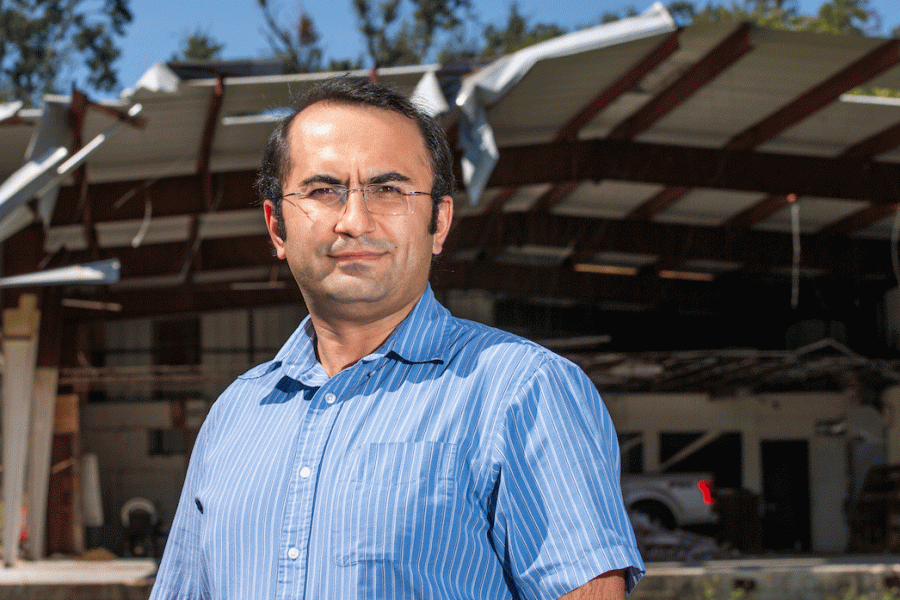
In some places in Florida and around the country, there is a time before the storm and a time after.
Andrew in South Florida. Michael in the Panhandle. Maria in Puerto Rico. Katrina along the Gulf Coast. These hurricanes killed many and caused billions of dollars in damage. They challenged the resilience of the communities in their path, especially for communities that didn’t have many resources to deal with natural disasters before the storms.
Helping communities develop the infrastructure necessary to recover quickly from disasters like hurricanes and pandemics is the focus of the Resilient Infrastructure and Disaster Response (RIDER) Center at the FAMU-FSU College of Engineering. The center is an information and research hub that helps communities improve their ability to plan, prepare for and recover from natural disasters and other threats.
“We are focusing on how we can achieve resiliency for our communities,” said Eren Erman Ozguven, an associate professor of civil and environmental engineering at the college and the center’s director. “And when we say communities, we’re not only talking about cities and metropolitan areas, but we are talking about underserved areas, rural counties — those areas do not have resources like their urban counterparts.”
The RIDER Center is also one of the centers featured as part of Florida State University’s “Big Bets” initiative, a program designed to highlight public impact science and connect the centers with partners and donors interested in their work.
“With ‘Big Bets,’ FSU is looking to focus on a few existing research centers already doing work that has the potential to be even more crucial in the future,” said Interim Vice President for Research Laurel Fulkerson. “The team at RIDER is conducting research that has real-world impact on communities facing challenges in the aftermath of an event — everything from hurricanes to pandemics. Their interdisciplinary approach considers the whole slate of problems communities could potentially face.”
Florida is home to communities ranging from counties with populations of fewer than 20,000 to some of the nation’s largest metro areas, and those communities have different needs and resources for disaster planning. The gap in preparedness and expertise — the “resilience divide” between big and small and rich and poor communities — is what the RIDER Center works to close.
For example, in some counties with small populations, there is no one dedicated to disaster planning. Another official, like a sheriff might handle those duties as time permits or when an emergency arises. The center’s goal is to provide resources and tools for communities that wouldn’t otherwise have them, so officials in those places can adapt them to on-the-ground conditions.
Urban areas are more likely to have dedicated disaster planners, but they have their own unique disaster challenges that the center’s research will also address. Little to no research focuses on integrating the resilience needs within and across urban and rural communities, which is a need the center hopes to make progress on.
“Resiliency is not one size fits all,” said Tarek Abichou, a professor of civil and environmental engineering at the FAMU-FSU College of Engineering and one of the center’s executive directors. “Resiliency cannot be the same planning for every community. We think that every community has to have access to some sort of resiliency capacity. We think that this center will try to fill that gap and provide services that these communities cannot afford to have all the time.”
That help will come in the form of strategic insights informed by research done by the faculty, as well as tools and planning documents they develop that can be used by local officials. GIS tools that can map the extent of historical flooding and estimate future risk, for example, can help determine the best place for a shelter, optimal evacuation routes or debris removal plans.
Analyzing flooding risk and evacuation routes is just part of the work. Researchers are looking for solutions to all sorts of problems that natural disasters create. Those include developing operational procedures for public libraries — which offer support services for emergency services and the public during natural disasters — as well as creating models for local governments and aid organizations to determine which regular shelters could be repurposed into shelters for people with special needs or pet-friendly shelters.
An interdisciplinary approach to these issues is key, Ozguven said.
“Natural disasters are intrinsically interdisciplinary problems because they affect so many parts of our lives,” he said. “Resilience depends on many factors, and researchers from a variety of disciplines can all play a role in helping us understand and prepare for emergencies.”
Along with offering resources like those, the center organizes training for officials so faculty can share their knowledge directly with the people tasked with planning for and recovering from disasters. Several workshops are already planned this year, thanks to grants from the National Science Foundation.
The center’s work is especially helpful for vulnerable populations, such as older adults, who might have fewer resources to help themselves in times of disaster.
For example, Hurricane Irma in September 2017 showed that many seniors were reluctant to evacuate due to their fear for dangerous environments, loss of property, and language/cultural barriers, Ozguven said. For seniors who may have trouble with the daily tasks of life, the evacuation process can be especially complicated and stressful.
“We are engineers,” Abichou said. “Many of our faculty have been working on resiliency related issues or sustainability related issues, but we tended to solve engineering technical problems — we dealt with structures, with buildings, with bridges. What we think the RIDER Center will achieve is to bring people into what we’re doing. That’s why we think this is a multi-disciplinary effort that will take engineering out of the buildings and the structures and bring it into people’s lives.”




